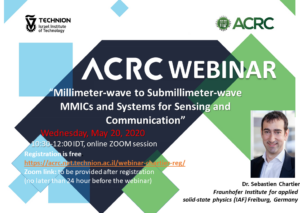Webinar

The Advanced Circuit Research Center (ACRC) ) is inviting you to a free online seminar on “Millimeter-wave to Submillimeter-wave MMICs and Systems for Sensing and Communication” given by Dr. Sebastien Chartier, Fraunhofer Institute for applied solid-state physics (IAF) Freiburg, Germany.
The transmission of electromagnetic waves in the atmosphere features local maxima in many frequency bands between 94 GHz and 850 GHz, making them especially attractive for millimeter-wave high-speed data links and long-distance high-resolution radar and imaging systems. High operating frequencies allow for precise geometrical resolution due to high absolute bandwidth and small wavelength and reduce the size of components and antennas as well, predestining them for lightweight spaceborne and airborne systems. In comparison to visible and infrared radiation, a particular benefit of millimeter-waves for imaging and sensing applications is the penetration of dust, fog, rain, snow, and textiles.
This talk covers a broad variety of MMICs and modules developed at the Fraunhofer Institute for Applied Solid State Physics (IAF) targeting applications for frequencies up to 600 GHz and above, using in-house advanced InGaAs/InAlAs metamorphic high electron mobility transistor (mHEMT) technologies. To achieve very high MMIC operating frequencies, the maximum frequency of oscillation (fmax) of the transistors was boosted to over 1000 GHz by increasing the indium content in the transistor channel and reducing the gate length down to 20 nm. The presented MMICs are essential components in wireless communication systems (including “Beyond 5G” mobile communication), sensor systems, as well as cryogenic MMICs for radio astronomy receivers and future quantum computing hardware. Additionally to single ultra-low-noise amplifiers, mixers, frequency multipliers, Tx/Rx and TRx circuits, different approaches for module packaging and system realization will also be covered.
Sébastien Chartier received the Master’s degree in microwave engineering from the University of Lille, Lille, France, in 2003 and the Dr.-Ing. Degree from the University of Ulm, Ulm, Germany, in 2009. In 2004, he joined the Institute of Electron Devices and Circuits, University of Ulm, as a member of the scientific staff, working on the design, assembly and testing of millimeter-wave SiGe BiCMOS MMICs, especially for application in automotive radar systems. In 2007, he joined the Fraunhofer Institute for applied solid-state physics (IAF) in Freiburg, Germany, working on microwave and millimeter-wave MMIC design based on advanced metamorphic HEMT technologies for radar, communication, medical and radio astronomy applications. From 2009 to 2017, he worked at Airbus Defence and Space GmbH in Ulm, Germany (now Hensoldt GmbH) as an R&D engineer working on SiGe BiCMOS based circuit design for next generation T/R modules for phased-array radar and communication systems. He was appointed specialist for RF system-on-chip in 2011 and Expert for system-on-chip in 2013. In 2017, he joined NXP Semiconductors Germany GmbH, Hamburg, Germany, as a subsystem design leader working on Si-based radar chips for next generation advanced driver assistance systems (ADAS). In 2019, he joined the Institute of Robust Power Semiconductor Systems (ILH), University of Stuttgart, Stuttgart, Germany as group leader for microwave and terahertz electronics. In 2020, he joined the Fraunhofer Institute for applied solid-state physics (IAF) in Freiburg, Germany as Head of the Business Unit “High Frequency Electronics”. Dr. Chartier has authored and co-authored more than 30 peer-reviewed papers and holds two patents. He was member of the technical program committee of the 2017 European Microwave Week and of the 2019 German Microwave Conference. He is an invited lecturer at the University of Stuttgart since 2020. He is member of IEEE, The Association of German Engineers (VDI), The Association for Electrical, Electronic and Information Technologies (VDE) and the European Microwave Association (EuMA).
Please sign up and join us on Wednesday, May 20 at 10:30 IDT.
Link to the Zoom session will be provided after the registration.
Important: The participation is free of charge, but registration is required


